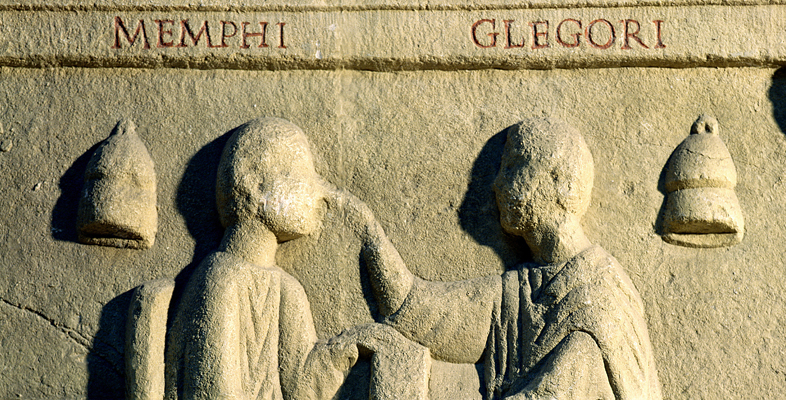3.1 A good complexion
Many remedies for facial imperfections exist in medical and other literature from the ancient world. For example, Pliny the Elder’s Natural History (20.4.9–10) includes the following list of the benefits of the ‘squirting cucumber’:
Elaterium promotes menstruation but causes abortion when taken by women with child. It is good for asthma and also for jaundice when injected into the nostrils. Smeared in the sunshine on the face, it removes freckles and spots.
Both Greek and Roman writers who discuss their own societies tend to associate the use of face paints, false hair and hair dye mostly with prostitutes. But the texts are part of a long anti-cosmetic tradition, which present ‘respectable’ women who use them as likely to be unfaithful. In the extended passage that follows, from a treatise by Xenophon, Socrates and Critinus talk about how best to manage your estate or household: the ancient Greek word is oikos, from which ‘economy’ comes from. In the course of their discussion, Socrates recounts a conversation he once had with Ischomachus, a ‘kalos te kagathos anêr’, literally a ‘beautiful and good man’ and normally translated ‘true gentleman’. He married his wife when she was 14, and trained her up as a wife so that she could manage the household without him. Ischomachus notices one day that:
her face was made up: she had rubbed in a lot of white lead in order to look even whiter than she is, and alkanet juice to make her cheeks rosier than they truly were.
Alkanet is a red dye made from a plant. White lead is toxic, so this attempt to give a healthy appearance would be potentially very dangerous, particularly if the lead penetrated thinner skin, such as the area around the eyes. Ischomachus, according to Socrates, tried to stop his wife using cosmetics:
please assume, wife, that I do not prefer white paint and alkanet dye to your real color; but just as the gods have made horses delight in horses, cattle in cattle, sheep in sheep, so human beings find the human body undisguised most delightful. … people who live together are bound to be found out if they try to deceive one another … when they’re just out of bed and not yet dressed, or they perspire and are lost, or a tear convicts them, or the bath reveals them as they truly are!
He went on to describe his young wife’s obedience to his request:
Wouldn’t you know, she gave up such practices from that day forward, and tried to let me see her unadorned and as she should be. Still, she did ask whether I could advise her on one point: how she might make herself really beautiful instead of merely seeming to be … it was excellent exercise to mix flour and knead dough; and to shake and fold clothing and linens; such exercise would give her a better appetite, improve her health, and add natural colour to her complexion.
So, housework, conveniently, provides the exercise to ensure health!
Even more distaste for cosmetics comes across in a dialogue about love from the fourth century CE, Pseudo-Lucian, Amores (Affairs of the Heart 39–41) (the text used to be attributed to the second century CE writer Lucian but seems to have been written rather later than this). The speaker says that women are particularly ugly in the morning, and it’s better not to see them then:
They’re surrounded by old women and a throng of maids as ugly as themselves who doctor their ill-favoured faces with an assortment of medicaments. … numerous concoctions of scented powders are used to brighten up their unattractive complexions.
The speaker goes on to talk about using rouge, yellow hair dye, curling tongs, tight shoes and heavy jewellery which cuts into women’s skin. In the period of the Roman Empire, writers equated women’s use of perfumes from all over the empire with the sort of luxury practices which were opposed to traditional Roman ideals of simplicity (Pliny the Elder, Natural History, 12.84).
There is some evidence for the reality of ancient cosmetics. For example, in 2003, a small tin container from the second century CE was found in a dig in Tabard Square, London. It contained what has been identified as a cosmetic face cream. Richard Evershed of Bristol University analysed the ingredients and found that, instead of lead, it achieved the white effect through tin oxide. The tin would have probably come from Cornwall, and the fat in it was from cattle. The other main ingredient was starch, perhaps from boiling roots. The initial effect is greasy, but then the starch leaves an overall ‘powdery’ texture.
Men’s personal care also came under some attack in antiquity. The Romans believed that washing, cutting one’s hair and how one walked and dressed were all part of what sets humans apart from animals. But how far should a man go? In his Art of Love, Ovid includes dealing with nostril hair and clipping nails as acceptable for men (1.505–514).

